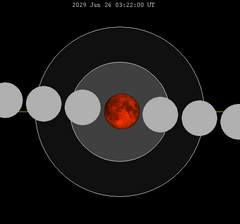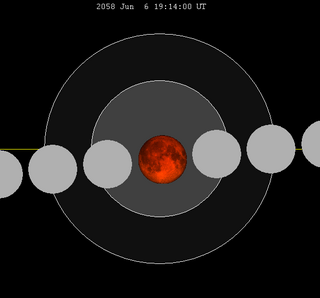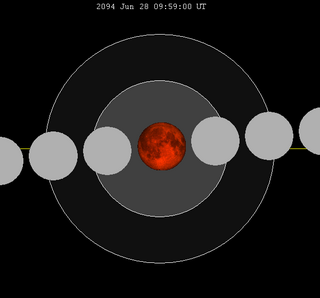| Partial eclipse | |||||||||||||
| Date | April 12, 1903 | ||||||||||||
|---|---|---|---|---|---|---|---|---|---|---|---|---|---|
| Gamma | 0.4798 | ||||||||||||
| Magnitude | 0.9677 | ||||||||||||
| Saros cycle | 130 (28 of 72) | ||||||||||||
| Partiality | 196 minutes and 31 seconds | ||||||||||||
| Penumbral | 330 minutes and 6 seconds | ||||||||||||
| |||||||||||||
A partial lunar eclipse took place on Sunday, April 12, 1903. This nearly total lunar eclipse of Saros cycle 130 preceded the first total eclipse on April 22, 1921. The Moon was almost covered by the Earth's shadow in a very deep partial eclipse, which lasted 3 hours and 17 minutes, with 96.77% of the Moon in shadow at maximum eclipse.
Lunar saros series 130, repeating every 18 years and 11 days, has a total of 71 lunar eclipse events including 56 umbral lunar eclipses (42 partial lunar eclipses and 14 total lunar eclipses). Solar Saros 137 interleaves with this lunar saros with an event occurring every 9 years 5 days alternating between each saros series.
| Greatest | First | |||
|---|---|---|---|---|
 The greatest eclipse of the series will occur on 2029 Jun 26, lasting 102 minutes. [1] | Penumbral | Partial | Total | Central |
| 1416 Jun 10 | 1560 Sep 4 | 1921 Apr 22  | 1957 May 13  | |
| Last | ||||
| Central | Total | Partial | Penumbral | |
2083 Jul 29  | 2155 Sep 11 | 2552 May 10 | 2678 Jul 26 | |
| 1903 Apr 12 | 1921 Apr 22 | 1939 May 3 | |||
 |  |  |  |  |  |
| 1957 May 13 | 1975 May 25 | 1993 Jun 4 | |||
 |  |  |  |  |  |
| 2011 Jun 15 | 2029 Jun 26 | 2047 Jul 7 | |||
 |  |  |  |  |  |
| 2065 Jul 17 | 2083 Jul 29 | ||||
 |  |  |  | ||
A lunar eclipse will be preceded and followed by solar eclipses by 9 years and 5.5 days (a half saros). [2] This lunar eclipse is related to two hybrid solar eclipses of Solar Saros 137 (1 hybrid solar eclipse after 1901).
| April 17, 1912 |
|---|
 |

A total lunar eclipse took place on May 4, 2004, the first of two total lunar eclipses in 2004, the second being on October 28, 2004.

A total lunar eclipse took place on 15 June 2011. It was the first of two such eclipses in 2011. The second occurred on 10 December 2011. While the visual effect of a total eclipse is variable, the Moon may have been stained a deep orange or red colour at maximum eclipse.

A penumbral lunar eclipse took place on April 24, 2005, the first of two lunar eclipses in 2005. At maximum eclipse, 86.5% of the Moon's disc was partially shaded by the Earth, which caused a slight shadow gradient across its disc; this subtle effect may have been visible to careful observers. No part of the Moon was in complete shadow. The eclipse lasted 4 hours and 6 minutes overall, and was visible from east Asia, Australia, and the Americas.

A total lunar eclipse took place at 0308 UT (GMT) on Thursday, August 17, 1989, the second of two total lunar eclipses in 1989.

A total lunar eclipse will take place on May 26, 2040. The northern limb of the moon will pass through the center of the Earth's shadow. This is the second central lunar eclipse of Saros series 131.

A total lunar eclipse will take place between Monday and Tuesday, June 25-26, 2029. A central total eclipse lasting 1 hour and 41 minutes 53 seconds will plunge the full Moon into deep darkness, as it passes right through the centre of the Earth's umbral shadow. While the visual effect of a total eclipse is variable, the Moon may be stained a deep orange or red color at maximum eclipse. It will be able to be seen from most of the Americas, Western Europe and Africa. The partial eclipse will last for 3 hours and 39 minutes 32 seconds in total.

A total lunar eclipse took place on Friday, June 4, 1993, the first of two total lunar eclipses in 1993, the second being on Monday, November 29. The Moon was plunged into darkness for 1 hour and 36 minutes, in a deep total eclipse which saw the Moon 56% of its diameter inside the Earth's umbral shadow. The visual effect of this depends on the state of the Earth's atmosphere, but the Moon may have been stained a deep red colour. The partial eclipse lasted for 3 hours and 38 minutes in total. The moon passed through the center of the Earth's shadow.

A total lunar eclipse will take place on July 7, 2047. It will last 1 hour 40 minutes and 49 seconds and will plunge the full Moon into deep darkness, as it passes right through the centre of the Earth's umbral shadow. While the visual effect of a total eclipse is variable, the Moon may be stained a deep orange or red colour at maximum eclipse. This will be a great spectacle for everyone who sees it. The partial eclipse will last for 3 hours and 39 minutes in total.
A total lunar eclipse took place on Saturday, May 24 and Sunday, May 25, 1975, the first of two total lunar eclipses in 1975. The Moon was plunged into darkness for 1 hour and 28 minutes in a deep total eclipse which saw the Moon 43% of its diameter inside the Earth's umbral shadow. The visual effect of an eclipse depends on the state of the Earth's atmosphere, but the Moon may have been stained a deep red colour. The partial eclipse lasted for 3 hours and 35 minutes in total. Occurring only 4.4 days after perigee, the Moon's apparent diameter was 0.7% larger than average. The moon was 377,010 km from the Earth at greatest eclipse.
A total lunar eclipse took place on Thursday, April 24, 1986, the first of two total lunar eclipses in 1986, the second being on October 17, 1986. The Moon was plunged into darkness for 1 hour, 3 minutes and 34.8 seconds, in a deep total eclipse which saw the Moon 20.217% of its diameter inside the Earth's umbral shadow. The visual effect of this depends on the state of the Earth's atmosphere, but the Moon may have been stained a deep red colour. The partial eclipse lasted for 3 hours, 18 minutes and 46.8 seconds in total. The Moon was just 1.2 days before perigee, making it 5.3% larger than average.

A total lunar eclipse will take place between Sunday, September 7 and Monday, September 8, 2025. The Moon will barely miss the center of the Earth's shadow. It will be the second of two total lunar eclipses. Occurring roughly 3 days before perigee, the Moon will appear larger than usual.

A total lunar eclipse took place on Monday, May 13, 1957, the third of fourteen total lunar eclipses of Lunar Saros 130. The Moon was plunged into darkness for 1 hour and 18 minutes, in a deep total eclipse which saw the Moon 30% of its diameter inside the Earth's umbral shadow. The visual effect of this depends on the state of the Earth's atmosphere, but the Moon may have been stained a deep red colour. The partial eclipse lasted for 3 hours and 32 minutes in total.

A total lunar eclipse took place on Wednesday, May 3, 1939. A shallow total eclipse saw the Moon in relative darkness for 1 hour and 2 minutes. The Moon was 18% of its diameter into the Earth's umbral shadow, and should have been significantly darkened. The partial eclipse lasted for 3 hours and 27 minutes in total.
A total lunar eclipse took place on Friday, April 22, 1921. This was the first total lunar eclipse of Saros cycle 130. A shallow total eclipse saw the Moon in relative darkness for 40 minutes and 6 seconds. The Moon was approximately 7% of its diameter into the Earth's umbral shadow, and should have been significantly darkened. The partial eclipse lasted for 3 hours and 22 minutes in total.

A total lunar eclipse will take place on June 6, 2058. The Moon will pass through the center of the Earth's shadow.

A total lunar eclipse will take place on July 29, 2083. The Moon will be plunged into darkness for 1 hour and 30 minutes, in a deep total eclipse which will see the Moon 48.3% of its diameter inside the Earth's umbral shadow. The visual effect of this depends on the state of the Earth's atmosphere, but the Moon may be stained a deep red colour. The partial eclipse will last for 3 hours and 33 minutes in total.

A total lunar eclipse will take place on July 17, 2065. A dramatic total eclipse lasting 1 hour and 37 minutes will plunge the full Moon into deep darkness, as it passes right through the centre of the Earth's umbral shadow. While the visual effect of a total eclipse is variable, the Moon may be stained a deep orange or red colour at maximum eclipse. This will be a great spectacle for everyone who sees it. The partial eclipse will last for 3 hours and 36 minutes in total. The moon will pass through the center of the Earth's shadow.

A total lunar eclipse will take place on June 28, 2094. The Moon will pass through the center of the Earth's shadow. While the visual effect of a total eclipse is variable, the Moon may be stained a deep orange or red color at maximum eclipse. With a gamma value of only 0.0288 and an umbral eclipse magnitude of 1.8234, this is the greatest eclipse in Saros series 131 as well as the second largest and darkest lunar eclipse of the 21st century.
A partial lunar eclipse took place on Thursday, March 12, 1914.

Saros cycle series 130 for lunar eclipses occurs at the moon's ascending node, repeats every 18 years 11+1/3 days. The 130th lunar saros is associated with Solar Saros 137.